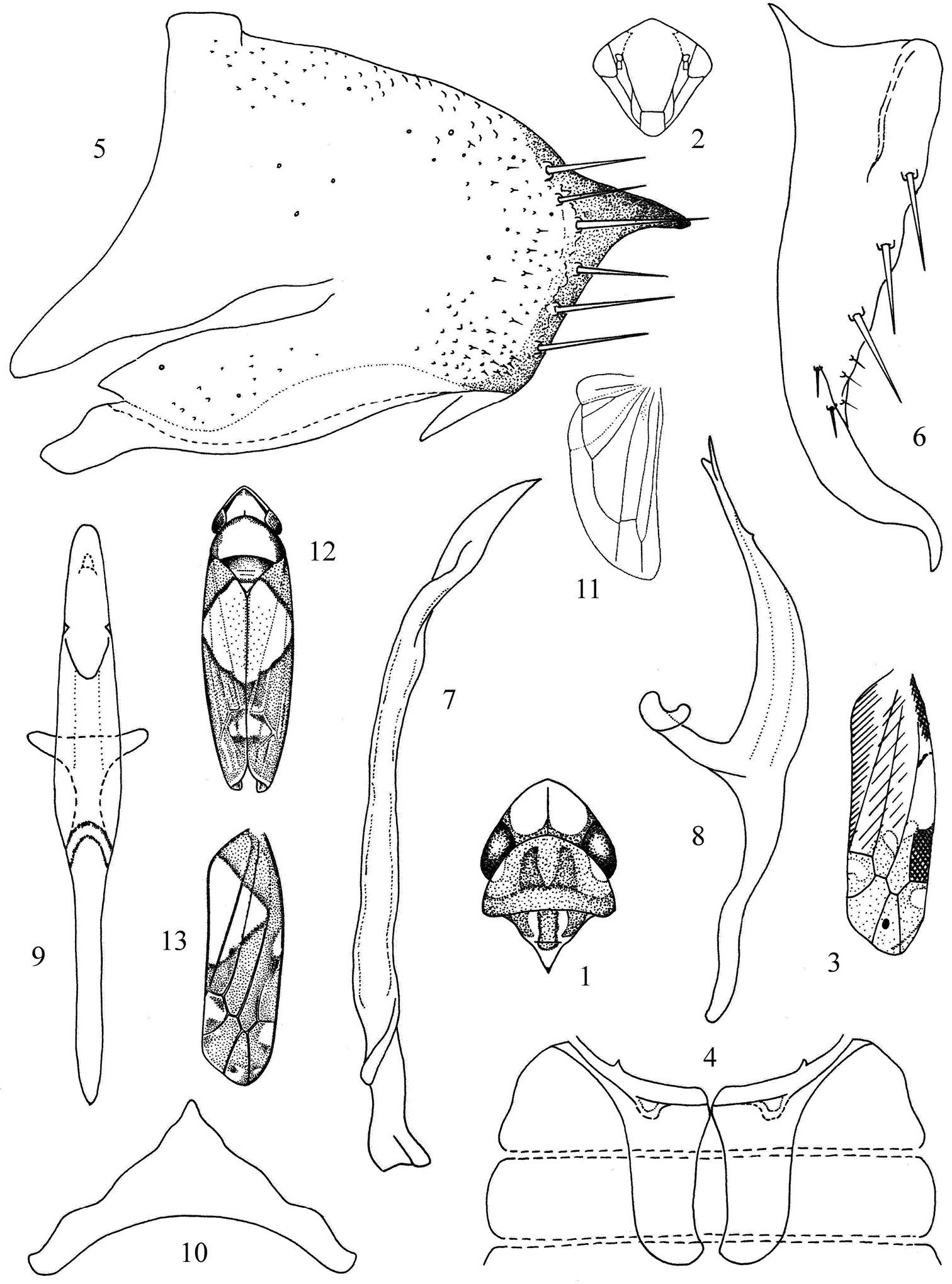






(C) 2012 Yuehua Song. This is an open access article distributed under the terms of the Creative Commons Attribution License 3.0 (CC-BY), which permits unrestricted use, distribution, and reproduction in any medium, provided the original author and source are credited.
For reference, use of the paginated PDF or printed version of this article is recommended.
A new species, Zyginella menghaiensis sp. n. (Hemiptera: Cicadellidae: Typhlocybinae: Zyginellini), is described from Chinaand a key to species of Zyginella from China is provided.
Morphology, taxonomy
The leafhopper genus Zyginella was established by Löw in 1885. The genus belongs in the tribe Zyginellini of Typhlocybinae and consists of twenty-two species distributed in the Oriental, Palaearctic and Afrotropical Regions. Members of the genus can be distinguished by the distinct dark spot on the 3rd apical cell of the forewing (Fig. 3) and in the male genitalia by the male pygofer with short ventral caudal process and long macrosetae on the posterodorsal margin (Fig. 5) and style elongate, slender throughout length with truncate base (Fig. 7).
Recent taxonomic work on the genus includes
http://species-id.net/wiki/Zyginella
Forewing (Fig. 3) with distinct dark spot on 3rd apical cell.
Head (Fig. 1) acutely produced medially, about as wide as greatest width of pronotum; coronal suture prominent. Forewing (Fig. 3) with 1st apical cell short. Hind wing (Fig. 11) with submarginal vein confluent with Cu1 markedly distad of point of fusion of Cu1 with M3+4.
Male pygofer (Fig. 5) with short process on lateroventral margin and numerous long macrosetae on posterodorsal surface. Subgenital plate usually forming a pocket-like structure at tip or tapering towards apex (Fig. 6). Style (Fig. 7) broadened and truncate at base. Aedeagal shaft (Figs 8, 9) usually curved dorsally; preatrium long or short; dorsal apodeme narrow. Connective (Fig. 10) V- or Y-shaped; lateral arms long; central lobe absent.
Oriental region, Palaearctic region, Afrotropical region.
Key to Chinese species of the genus Zyginella
(males only couplets 5–7)
| 1 | Vertex with black stripe between eyes subapically (Fig. 12) | 2 |
| – | Vertex without black stripe between eyes subapically (Fig. 1) | 4 |
| 2 | Pronotum with two black transverse stripes | Zyginella citri (Matsumura) |
| – | Pronotum without black transverse stripes | 3 |
| 3 | Vertex and pronotum with pair of dark spots respectively | Zyginella mali (Yang) |
| – | Vertex and pronotum without spots | Zyginella minuta (Yang) |
| 4 | Forewings without a large rhombus-like patch along inner margin subbasally (Fig. 3) | 5 |
| – | Forewings with a large rhombus-like patch along inner margin subbasally (Figs 12, 13) | 7 |
| 5 | Aedeagus preatrium well developed, about as long as length of aedeagal shaft (Figs 8, 9) | 6 |
| – | Aedeagus preatrium vestigial | Zyginella orla Dworakowska |
| 6 | Aedeagal shaft with a single short dorsal process subapically (Figs 8, 9) | Zyginella menghaiensissp. n. |
| – | Aedeagal shaft without a single short dorsal processes subapically | Zyginella tsauri Chiang, Hsu & Knight |
| 7 | Pygofer lobe with a hook-like process caudo-dorsally | Zyginella punctata Zhang |
| – | Pygofer lobe without hook-like process caudo-dorsally | Zyginella taiwana Chiang, Lee & Knight |
urn:lsid:zoobank.org:act:090D3B2C-B357-4E11-9F81-AC71C63C6743
http://species-id.net/wiki/Zyginella_menghaiensis
Figures 1–11Head and thorax yellowish brown; vertex with lateral margins with soft red tinge; eyes brownish grey; pronotum brownish with two longitudinal darker stripes; scutellum with basal triangles testaceous. Forewing (Fig. 3) reddish brown near base, dark red between 4th apical cell and brochosome-field and light brown around apex; 3rd apical cell with a blackish brown spot.
Coronal suture (Fig. 1) extending nearly to anterior margin of vertex. Forewing (Fig. 3) with 3rd apical cell not petiolate at base.
Abdominal apodemes (Fig. 4) slender, slightly extended beyond 4th sternite.
Pygofer lobe (Fig. 5) broad, with a large sclerotized process near dorsal margin and another process arising from about ventro-caudal margin; six long macrosetae distributed along caudal margin and numerous short microsetae scattered on lateral surface. Subgenital plate (Fig. 6) long, gradually tapered towards apex and curved apically, beak-like; with three long macrosetae along upper margin. Style (Fig. 7) elongate, slender throughout length with truncate base. Aedeagal shaft (Figs 8, 9) curved dorsad in lateral view with single small dorsal process subapically; gonopore large, apical on ventral surface with small tooth on each lateral margin; preatrium long, about as long as aedeagal shaft; dorsal apodeme narrow. Connective (Fig. 10) Y-shaped with very short stem and long strongly divergent lateral arms; central lobe absent.
Body length males 2.9~3.1 mm.
Holotype, male, China: Yunnan Province, Menghai County, 23 July 2008, coll. YUE-HUA SONG. Paratypes: two males, same date as holotype.
The new species is similar to Zyginella tsauri Chiang, Hsu & Knight (1989), but the forewing has a large dark costal patch (Fig. 3) and the aedeagus has a single short dorsal process subapically and a small tooth on each lateral margin of the gonopore (Figs 8, 9).
Zyginella species 1–11 Zyginella menghaiensis sp. n. 1 Head and thorax, dorsal view 2 Face 3 Forewing 4 Abdominal apodemes 5 Pygofer lobe, lateral view 6 Subgenital plate 7 Style 8 Aedeagus, lateral view 9 Aedeagus, ventral view 10 Connective 11 Hindwing 12–13 Zyginella minuta (after Yang, 1965) 12 Adult, dorsal view 13 Forewing.
The new species is named for its type locality: Menghai.
We would like to express our sincere gratitude to Mr. M. D. Webb (Natural History Museum, London, UK) for his detailed remarks and suggestions on the manuscript. The project was supported partly by the “Scientific Research Foundation for Doctor’s Degree Members, Guizhou Normal University: Taxonomic Study of Erythroneurini and Zyginellini from South China Karst Area”, the “Social Development and Science & Technology of People’s Livelihood Program of Guiyang City (No. 201110362)”, the “Key Technologies R&D Program of Guizhou Province (SY[2010]3068)” and the “Guizhou Provincial Natural Science Foundation of China (No. [2010]2063)”.
